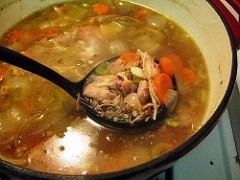- Author: Darrell Fluman
- Editor: L. Watts
Thanksgiving Holiday isn't that far away in terms of planning for the feast.
I have a long time tradition of smoking a turkey for the holiday and although most of my extended family are not big "smoked meat" fans, there are enough of us to make it worth the extra effort. My favorite part is the Smoked Turkey Noodle Soup to follow. The apple sweet/apple smoky flavor is heaven in a bowl.
On Monday before make a tea of the apple cider and dry spices, simmer for 5 minutes, leave to steep, covered, for 1 hour and chill. This is used for the marinade.
I marinate the holiday bird in a brine of cold apple cider, sugar, salt, dry oregano, and dry basil starting mid-day Tuesday in a 5 gallon bucket in the 'fridge.
Early Thursday (read 4 a.m.) the bird gets rinsed and is set to dry while the smoker gets going.
I prefer to smoke poultry over straight apple wood, but it seems to get harder to find the shredded 100% apple wood every year. Sometimes if I don't start searching early enough I settle for a mix of alder and apple. Really, there is only a subtle difference with the mix and 100% alder is fine for poultry. 3 to 4 hours of cold smoke raises the bird's temperature to 90-95of and leaves the skin a beautiful mahogany color.
The cavity is stuffed loosely with 2 parts apples to 1 part onions, 1 part celery. Apples in 16ths (apple wedged into eighths and cut them in half), onions in the same 16ths and separate most layers.
Stand the bird on end and pour the pieces in. Don't pack them in. Two big apples and one big onion is good for a medium bird. Any extra goes in the roasting pan.
Slip some fresh oregano sprigs under the skin.
Take a double layer of aluminum foil and make a preformed cover for the breast. Leave some extra along the side to tuck under the drumstick. You may need this near the of cooking to prevent the breast from over browning.
Roast with 1/2 gallon apple cider, extra apples, extra onions, carrot chunks and other root veggies as you prefer in the pan, i.e., turnips, parsnips, rutabagas, golden beets, and small potatoes. No red beets. Plenty of veggies because you want some to go in the stock and some to serve.
Roast breast side down until the last hour. Flip the bird over and cook to 165of in the thigh meat. You can baste with the pan juices or not. I find little difference to justify the extra effort.
A remote thermometer is a great investment as it gives you the temp. without having to open the door which lets the heat out and makes the cooking that much longer. Your oven can drop 50o or more each time you open the door and it takes at least 20 minutes to reach the set temp. again.
Check to make sure the breast isn't getting too brown. Use your pre-made cover if needed.
When done [remove from the oven,cover the bird with foil and allow to rest for at least 10 minutes. Resist the urge to begin cutting or you will end up with a pan full of juice and a bone dry bird.
IS IT SOUP YET ?


Remove remaining meat from the carcass. Refrigerate.
Take the bird carcass, skin and everything else except any leftover potatoes in the pan and cover with cold water. Bring up to a slow simmer and cook for
1-1/2 to 2 hours, uncovered. Do not boil. This creates lots of small particles of protein that make your stock cloudy.
Allow to cool to a safe temperature and strain through a metal colander to separate out the big pieces then strain out the small stuff through cheesecloth or a flour sack towel. Do not squeeze out the towel. Discard everything you strained out.
You have cooked out all that nature has to offer.
Taste the stock. If you feel it is weak, simmer it to reduce the volume.
You may pressure can the clear stock @ 10 pounds pressure for 20 minutes for pints, 25 minutes for quarts, adjusting time for altitude. See the NCHFP.org website http://nchfp.uga.edu/ for details.
For soup you need the vegetables of your choice. Onions, carrots, turnips, parsnips, and potatoes come to mind. Cook to almost tender.
You need precooked al dente egg noodles. I like extra wide. If you cook the noodles in the stock the volume will be reduced by the absorption of the noodles. Your choice.
I think it is easier to control the texture of the noodles if I cook them separate and add them in at the last minute. I don't like overcooked noodles.
Add the meat. Season to taste. Enjoy.
- Author: L. Watts
Do you have a freezer? Have you checked it lately? You KNOW you are supposed to be keeping track of what goes in and out of it, right?
Oh, woe to those of us that have freezers but do not and have not taken care of them. Who knows what lies in yon chilly depths of my freezer. I have dug around in the baby freezer on our back patio and have discovered many things. Some are things I know about—the two smaller turkeys I purchased during last year's holiday. Some things I should have never placed in the freezer in the first place—like the family pack of rib steaks from unknown years ago, received after a freezer transfer. Other things I am using steadily: the chicken breasts that I got, boneless and skinless for an unbelievable price. More things I am not using steadily: Rhubarb cleaned, sliced, and frozen on a whim. Other stuff like organic strawberries (that I got at a really low price and have yet to use), hog jowl bacon (sounds weird, but is delicious!) and bones from dinners past. . .
The turkeys I will be cooking this summer. I like to smoke them slow on the barbeque and save the juices to make one mean, smoky gravy. And don't forget the sandwiches after! Gee, I could can up some smokey, cooked, turkey breast for sandwiches too.
The dogs will get a treat with the rib steaks. They are long gone to freezer burn, but, I betcha, cooked up in the pressure cooker they will make a dandy dog delicacy to be devoured by dancing, delighted doggies, no?(sorry, I am attracted and addicted to alliteration—Whoops, sorry again!)
We've been working on the chicken breasts. They are so huge that just one or two will serve several people; I put them in soup, sandwiches or grill them, slice them up and there's dinner. Found a recipe for chicken breast cooked like porchetta (Italian stuffed pork roast) I can try too.
Rhubarb. Strawberries. Hmmm, I'ma thinkin jam. Also thinking rhubarb sauce or maybe a rhubarb chutney. PIE—I forgot PIE!!! And Rhubarb Cream Cheese Pie. Dang. . . Curse you, my appetite—I am on a diet. Maybe can jam and chutney for this winter, though pie is calling my name wistfully. . .
Hog jowl bacon. I love bacon. This stuff was found at our local WinCo store. My sister and I were impressed with it being half the price of regular belly bacon, so we had to try it—we love bacon. We did try and the verdict is: TASTY and recommended. It has a very meaty flavor and a firmer texture and lots of pork-a-licious goodness. I love bacon and like the hog jowl stuff because I have to slice it and, for some reason, the fact that I must slice keeps me in control while cooking it. Normally with regular sliced bacon, I buy ONLY the number of slices we will need to cook for a meal; I love bacon (did I mention this before?) and if I buy a whole pound, I will cook the whole pound and I will eat most of that pound. So hog jowl bacon is good! So, with the number of tomatoes I planted this year, it looks to be a summer of BLTs and BLATs (a BLAT is a BLT with avocado!).
Then we come to dem bones from din-dins past. Bones from raw chicken, from raw pork. Bones from pork roasts and whole chicken carcasses. Usually a bone or two from a ham; maybe a few from some quick roasted spareribs. Stock made from all of these bone types together makes wonderful home-canned meaty goodness in a jar. I use stock in red spaghetti sauce, gravy, hot and sour soup, all sorts of things. When it is in jars, it is handy and it doesn't require electricity. I can make it as strong or reduced as I like, I can add salt or not as I please.
This year, my first canning-from-the-freezer job will be to make stock so will have more room in my freezer. This won't be such a chore as long as I can time it for cooler weather. The next canning-from-freeze job should be making something from that rhubarb and those strawberries because I need more room for more stuff I like to cook and room for MORE bones for stock.
The following is from the National Center for Home Food Preservation: http://nchfp.uga.edu/how/can_05/stock_broth.html
Meat Stock (Broth)
Please read Using Pressure Canners before beginning. If this is your first time canning, it is recommended that you read Principles of Home Canning.
Beef: Saw or crack fresh trimmed beef bones (with meat removed) to enhance extraction of flavor. Rinse bones and place in a large stockpot, cover bones with water. Place cover on pot and simmer 3 to 4 hours. Remove bones and cool broth; skim off excess fat and discard. If desired, remove any tiny amount of meat tidbits still clinging to bones and add back to the broth. Reheat broth to boiling and fill jars, leaving 1-inch headspace. Wipe rims of jars with a dampened clean paper towel.
Chicken or turkey: Place large carcass bones (with meat removed) in a large stockpot. Add enough water to cover bones. Cover pot and simmer 30 to 45 minutes or until any remaining tidbits of meat on bones easily fall off. Remove bones, cool broth and discard excess fat. If desired, remove any tiny amount of meat trimmings still clinging to bones and add back to the broth. Reheat broth to boiling and fill jars, leaving 1-inch headspace. Wipe rims of jars with a dampened clean paper towel.
Adjust lids and process following the recommendations in Table 1 or Table 2 according to the canning method used.
This document was adapted from the "Complete Guide to Home Canning," Agriculture Information Bulletin No. 539, USDA, revised 2009.
Reviewed July 2014. < http://nchfp.uga.edu/how/can_05/stock_broth.html >




